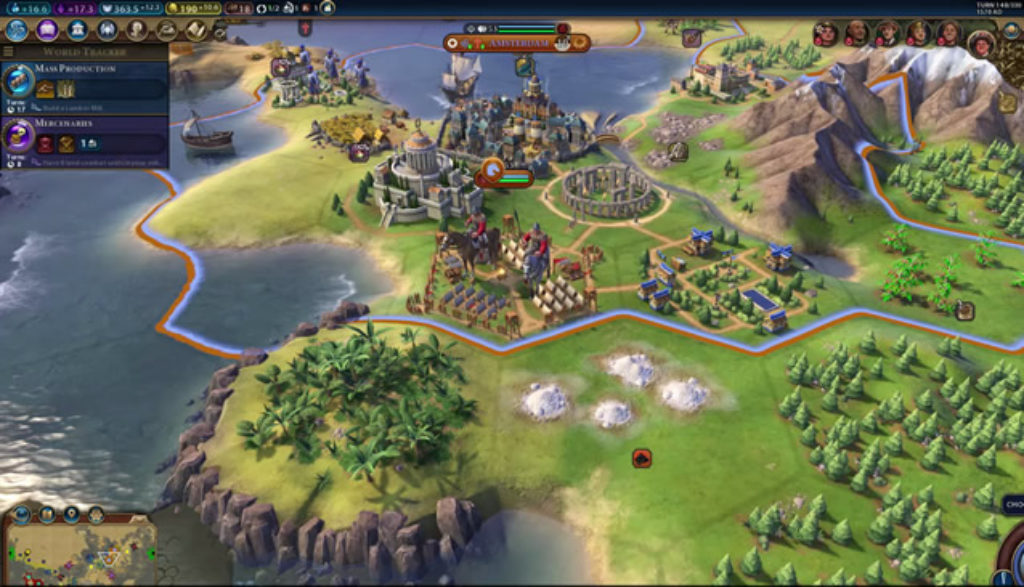
We’ve now had 25 years of Civilization games, titles that let players choose a historical leader and set forth to build a new world. But creator Sid Meier and his gamemaking crew keep cranking them out year after year anyway.
Of course, these contests haven’t all been the same. What fun would that be? Thus, each new iteration of the Civ experience remixes and reimagines the franchise’s basic concepts from previous generations. And expansion packs put more gameplaying flesh on those next-gen bones.
When Civilization VI first hit store shelves in October of 2016, for instance, the biggest retooling was its new hexagonal grid layout and city-district choices—both of which impacted how players would plan for and lay out their burgeoning urban enclaves. Another change affected how other world leaders might react to your influence, giving characters such as Egypt’s Cleopatra, America’s Teddy Roosevelt and Spain’s Phillip II more historically accurate temperaments. Some leaders just hated it when you went to war, while others were delighted.
Those elements are still a part of the game’s newest upgrade. But Sid Meier’s Civilization VI: Rise and Fall adds a number of other interesting wrinkles that provide players with still more decisions to make and historical pathways to explore.
The most important Rise and Fall addition is the way the game breaks your progress through history into manageable mini-games. Each historical era—Ancient, Classical, Medieval, Renaissance, etc.—becomes a measuring stick for your progress. You rack up Era Score points for performing various construction, governmental and exploratory actions. And that score dictates whether your society enters a Dark, Normal or Golden age in the next era.
A Golden age gives you the most civ-building bonuses, of course. But the new Era system also helps players keep track of their society’s progress and regress, while doling out new grab-your-boot-straps boosts to help you catch up to other in-game civilizations if you’ve fallen behind.
Another hefty Rise and Fall change is the game’s new Loyalty system. Each of the world’s cities now has a loyalty meter, which lets you know how happy citizens are with their current government and culture. Cities that get particularly unhappy not only drop in loyalty, they might get to the point of open rebellion and entertain thoughts of leaving a failing leader altogether. If, on the other hand, your cities are quite happy with your policies and leadership, denizens from a restless nearby metropolis might well be drawn to join your successful civilization.
To facilitate loyalty development, the game offers you the opportunity to appoint a governor to your cities and have these officials shape their communities in a specialized way. The governors have their own skills in various areas: One might be more interested in promoting religion, while another focuses on city fortifications or the acquisition of scientific learning. Each governor, then, gives his or her city a specific growth bonus.
Of course, along with new gaming systems and the requisite new historical leaders (such as Scotland’s Robert the Bruce and the Cree’s Poundmaker), you might wonder if Rise and Fall injects any new content issues. After all, while Genghis Khan is crushing someone with his mighty cavalry, it would be fair to expect a little muss. But, like past Civ titles, this one keeps the diplomatic channels free from salty language and the bird’s-eye-view battlefields sanitized of the presumed virtual carnage there.
In fact, other than a reference to having a glass of wine, the only potential issue here is the fact that Sid Meier’s Civilization games have always played just a little fast and loose with history itself. After all, the Netherlands’ leader Wilhelmina didn’t actually conquer American and build Big Ben and the Eiffel Tower in San Francisco—no matter what your latest Civ play-through might tell you.
So if you avoid using the game to help you make history-paper footnotes, Sid Meier’s world-building games offer fun and informative excursions into strategic city-shaping.

After spending more than two decades touring, directing, writing and producing for Christian theater and radio (most recently for Adventures in Odyssey, which he still contributes to), Bob joined the Plugged In staff to help us focus more heavily on video games. He is also one of our primary movie reviewers.